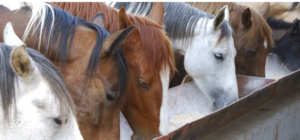 Keep an Eye on Calcium Balance: It is common knowledge that calcium is an essential mineral for strong and healthy bones and teeth in horses. Its importance in the nutrition of late-pregnant mares, weanlings, and growing horses. Especially young racehorses. Most horse people are aware of the increased requirements for calcium in these types of horses.
Keep an Eye on Calcium Balance: It is common knowledge that calcium is an essential mineral for strong and healthy bones and teeth in horses. Its importance in the nutrition of late-pregnant mares, weanlings, and growing horses. Especially young racehorses. Most horse people are aware of the increased requirements for calcium in these types of horses.
Most people also know that you need the correct calcium-to-phosphorus ratio of 2:1 for good health and balanced nutrition. Generally, if questioned, the average horse person couldn’t explain why this ratio is important. Furthermore, it is not enough to make sure that calcium and phosphorus levels are correct in the diet if availability of these minerals is compromised.
There are naturally occurring chemicals that may be available to the horse in everyday feeding regimes that can bind calcium and phosphorus and prevent them from being absorbed by the horse.
calcium and phosphorus:
It is not possible to discuss calcium balance in the body without mentioning the relationship between calcium and phosphorus. In the horse’s bones, the ratio of calcium to phosphorus is 2:1. Bone acts as a reservoir for calcium and phosphorus that can be tapped when dietary intake falls short of requirements. Calcium is also used in the body in a soluble form (as Ca++ ions) for nerve and muscle function. Therefore the body maintains rigid and controlled levels of calcium in the blood (2.9 to 3.9 mmol/liter) for these processes. A mechanism known as homeostasis. On the other hand, blood levels of phosphorus can fluctuate throughout the day and in response to exercise with no adverse effects.
This article will explain some of the danger spots to look for when you are considering the calcium availability of your horses’ diet. It will outline some of the dangers of calcium deficiency. In addition, how you can manipulate your management program to deal with problems associated with calcium being tied up in the diet by chemicals which make it less available to the horse.
Calcium Deficiency
In days of old when man still relied heavily on the horse for transport, for working the fields, and as a beast of burden, it was not uncommon to reward one’s trusty steed with a warm bran mash at the end of the day. The practice is still upheld by many experienced horsemen today.
Wheat-milling processes were less efficient in those days. Meaning that bran had slightly more nutritive value than the bran of today. As a feedstuff it still posed a problem with regard to calcium and phosphorus ratios. In those days, the disease colloquially known as “big head” was associated with workhorses and was something of a mystery. Big head was eventually linked to nutrition. In particular to dietary calcium balance, and hence became known as bran disease.
These names were given to the syndrome associated with calcium deficiency (nutritional secondary hyperparathyroidism) because of the fibrous growths responsible for swelling the facial bones of affected horses to unnatural proportions. These days it is generally only seen occasionally and in cases of extreme calcium deficiency caused by dietary deficiencies or in the presence of calcium-binding agents in the diet.
Wheat Bran:
Wheat bran is detrimental to calcium balance in two ways. First, 90% of the phosphorus in wheat bran exists as calcium phytate. binding both calcium and phosphorus and preventing their absorption into the horse’s bloodstream. The phytic acid involved in forming this compound can also bind to other dietary nutrients. Reducing their ability to be absorbed into the blood. These nutrients include copper, zinc, and manganese.
Secondly, wheat bran has ten times as much phosphorus as calcium. The combination of excessive dietary phosphorus and little available dietary calcium causes calcium to be leached from the bones to maintain and balance blood levels of calcium ions.
Wheat bran, however, is not the only culprit, and there are other foodstuffs available to horses that limit the amount of calcium that can be absorbed from the diet. Many grains are also high in phosphorus and low in calcium, and the majority contain some level of phytic acid. In addition, many introduced species of tropical and subtropical grasses exist in some pastures used for horse grazing or haymaking. Some of these grasses contain high levels of oxalic acid. Oxalic acid binds calcium by forming crystals of calcium oxalate in the grass stem and leaf in much the same way as phosphorus (phytic acid) forms phytates and prevents calcium absorption.
About Oxalic Acid:
Oxalic acid forms compounds with many elements to produce oxalates, some soluble and some insoluble. Levels of oxalates vary between plants, but in plants where calcium is present, oxalic acid forms an insoluble compound of calcium oxalate which reduces the amount of available calcium in the plant. Horses are completely unable to digest any of the calcium associated with calcium oxalate crystals. Some oxalate-containing plants also contain plenty of calcium, meaning that they are safe to feed despite their oxalate content. For a grass of this nature to be safe for feeding to horses without the risk of causing calcium deficiency, it must have a calcium to oxalate ratio of at least 0.5:1. Calcium deficiency caused by consumption of tropical grasses high in oxalates is also known as chronic oxalate poisoning.
Oxalate poisoning can be acute when grasses or weeds contain high concentrations of soluble oxalates that are absorbed rapidly into the bloodstream, binding calcium in the blood and rapidly reducing blood calcium levels. In this case, calcium oxalate crystals are formed in the kidney tubules and interfere with kidney function.
Oxalic Effects:
Affected horses may have muscle tremors and a staggering gait. They may appear lethargic and stop eating. Twitching of the muscles of the face may be seen, and death may occur if signs go unnoticed. Plants containing more than 2% soluble oxalate have the potential to cause acute oxalate poisoning, but horses usually have to be very hungry before considering these essentially unpalatable grasses and weeds as a food source.
Interestingly, many horsemen report increased incidence of calcium deficiency and cases of big head within a few weeks of rainfall. It may be that rainfall triggers new growth that the horses find more palatable. In addition, the increased moisture increases the oxalate content of tropical grasses. Whatever the reason, reports suggest that increased cases of big head after rainfall are seen within a matter of two to three weeks. Further research in this area could help horse owners to develop new pasture and grazing management prevention practices.
Clinical Signs of Calcium Deficiency
The clinical signs of chronic and extreme calcium deficiency are less frequently seen today than in the past. Yet it can still be a significant problem for horse owners. Iit is important to be aware of the signs. The disease can develop within two months of putting horses out on high-oxalate pastures. However, it more often takes six to eight months before symptoms are noticed.
A low blood calcium level (known clinically as hypocalcaemia) stimulates the release of parathyroid hormone from the parathyroid gland. This hormone is responsible for triggering the release of calcium from bones, particularly from the large bones of the head and limbs.
This calcium is released into the blood to bring calcium levels back to within normal ranges for optimal nerve, heart, and muscle function. If the horse has a high requirement for calcium, as in pregnant and lactating mares, growing horses, and heavily sweating performance horses, these effects will occur more readily and to a greater extent that in horses at maintenance levels of requirement.
Big Head:
As the bones become demineralized, they become weak and fragile. As a result, the horse may become lame and start to drop weight even though his feeding regimen has not altered. He will probably have a dull, depressed countenance and may appear to have swollen lower jawbones and/or loose teeth. The horse will appear stiff and have a shortened gait when trotted. The stiffness increasing as the horse is exercised. As the condition progresses, both upper and lower jaws and sometimes other facial bones become swollen (hence the name). Badly affected horses may suffer fractures and break down.
On postmortem examination, the swellings are comprised mostly of fibrous tissue with small sparse fragments of bone. The surfaces of the joints appear pitted and rough. The parathyroid glands of the throat and lower neck are visibly enlarged and distended. If the condition goes unnoticed and untreated, it is likely that the horse will suffer fatal or irreparable fractures and will need to be destroyed.
Treatments for Horses with Big Head
Examination by a veterinarian is needed to determine the severity of the disease. Perhaps involving radiographs and blood and urine tests. These may need to be repeated throughout treatment to examine the efficacy of the treatment program. The swellings of the facial bones may never completely disappear in severely affected horses. However, it is possible to get a horse back to full health after an episode of big head with time and correct attention to calcium-to-phosphorus ratios.
It can take up to 12 months for remineralization of bone to occur. Horses must be maintained at rest for this period of recovery. Suggested treatments include 2 kg (4.4 lb) of rock phosphate mixed with 3 kg (6.6 lb) of molasses or 2 kg (4.4 lb) of a combination of 1/3 ground limestone and 2/3 dicalcium phosphate (DCP) mixed with 3 kg (6.6 lb) molasses.
These supplements need feeding weekly. Either over a couple of days or split into daily feeds for a period of at least 6 months. Commercially available supplements can also be used and fed daily in smaller quantities than the above mixtures to provide the same benefit.
The Prime Suspects!
A few prime suspects should be investigated if a case of calcium deficiency has been diagnosed. The risk is greatest when these grass types make up all or almost all of the pasture available to the horse. These grasses should be identified and removed from the diet as soon as possible before causing any further damage.
-
Kikuyu grass has a calcium-to-oxalate ratio of 0.23:1. Grows very rapidly in summer and becomes rank and unpalatable relatively quickly.
-
Buffel grass has a calcium-to-oxalate ration of 0.22:1. Has a tufted appearance, often forming dense tussocks. A number of varieties vary from 0.2-1.5 m tall. Leaves vary in color from yellowish to bluish-green, are thin and narrow, and taper to a long point.
-
Pangola grass has a calcium-to-oxalate ratio of 0.37:1.
-
Green panic grass has a calcium-to-oxalate ratio of 0.32:1. Very green, lush growth, highly palatable, used in pastures and in hay.
-
Para grass has a calcium-to-oxalate ratio of 0.29:1. A coarse vigorous trailing grass, grows well in wet and flooded soils. Grows up to 1 m (39 inches) tall. More often used in hay as opposed to pasture.
-
Setaria grass has a calcium-to-oxalate ratio of 0.15:1. Grows up to 3 m (10 feet) tall with erect stems and leaves 15-30 cm long and 0.3-1.7 cm wide. Seedheads are spike-shaped and cylindrical.
-
Pigweed is a fleshy, low-to-the-ground weed with yellow flowers in the summer. Rarely consumed by horses but can cause acute oxalate poisoning if horses are hungry enough to eat large quantities. Oxalate concentrations range between 4.5 and 9.4% of the dried plant.
Prevention
To prevent calcium deficiency caused by grazing of subtropical grasses, look for and avoid these grasses in potential horse pastures. If pastures containing the subtropical grasses mentioned above must be used, avoid grazing them for longer than one month. If established pastures contain a large proportion of subtropical grass, calcium-to-phosphorus ratios of dietary intake should exceed 2:1. They may need to be as high as 3:1 to counterbalance the oxalate effect.
It is also useful to encourage the growth of leguminous plans such as lucerne (alfalfa). It is high in calcium. Lucerne gives the horses an oxalate-free alternative forage. If your pasture contains grasses such as kikuyu, it is wise to avoid using fertilizers with high phosphorus levels. For example, a poultry manure and superphosphate.
It may also be necessary to make available a calcium and phosphorus supplement. If so, using half the amount of the supplements mentioned in the treatment section weekly should prevent problems . Alternatively, feeding 20 kg (44 lb) of good-quality lucerne hay per horse per week ensures adequate calcium intake. It guards against oxalate poisoning.
Conclusion
Extreme calcium deficiencies are seen less today than in the past. However, the introduction of foreign subtropical grasses has meant that horse owners have another danger spot to look out for when investigating potential horse pastures.
It is important for horse owners to know that wheat bran is not the only culprit when it comes to big head or bran disease. It is a good idea to thoroughly check the species of grass in pastures to be used for horses. Take measures to prevent extended periods of grazing on unsafe pastures. If hazardous pastures make up the only grazing available, then supplements should be used to ensure adequate calcium intake to balance the effects of oxalic acid.
Questions about how to Keep an Eye on Calcium Balance?
Contact us at J & J Hay Farms by clicking here!
Article by KER.

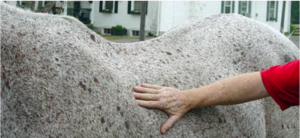 Why Can’t I Get My Horse Fat? Do you know of a hard keeper that has gained or maintained weight consistently on a feeding program until one day he just doesn’t? The needle hovers near a body condition of 5, lulling you into a sense of accomplishment. Then it begins to shift left, ever so slowly. As time goes on, your hard work melts away. The metabolic middle ground known as moderate body condition seems more distant than ever. The ribs peek out from his barrel; the vertebral chain juts above his topline musculature; and the neck no longer carries even a single globule of fat.
Why Can’t I Get My Horse Fat? Do you know of a hard keeper that has gained or maintained weight consistently on a feeding program until one day he just doesn’t? The needle hovers near a body condition of 5, lulling you into a sense of accomplishment. Then it begins to shift left, ever so slowly. As time goes on, your hard work melts away. The metabolic middle ground known as moderate body condition seems more distant than ever. The ribs peek out from his barrel; the vertebral chain juts above his topline musculature; and the neck no longer carries even a single globule of fat. Pasture Adequacy: Are Your Fields Doing Their Job? As herbivores, horses require large volumes of forages for optimal well-being. Just how much forage do horses require, though?
Pasture Adequacy: Are Your Fields Doing Their Job? As herbivores, horses require large volumes of forages for optimal well-being. Just how much forage do horses require, though? Feedstuffs for Horses: All About Beet Pulp. Fifty years ago, many knowledgeable horsemen would find it difficult to identify beet pulp or its potential value as a feedstuff for horses. Though its usefulness is now cemented among horse owners, beet pulp can still cause some confusion. Kathleen Crandell, Ph.D., a nutritionist for Kentucky Equine Research, answers eight questions about beet pulp and its role in equine nutrition.
Feedstuffs for Horses: All About Beet Pulp. Fifty years ago, many knowledgeable horsemen would find it difficult to identify beet pulp or its potential value as a feedstuff for horses. Though its usefulness is now cemented among horse owners, beet pulp can still cause some confusion. Kathleen Crandell, Ph.D., a nutritionist for Kentucky Equine Research, answers eight questions about beet pulp and its role in equine nutrition.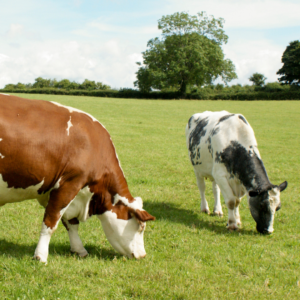 Best practices for managing 4 types of forage: Capitalize on your forage management to optimize cattle nutrition.
Best practices for managing 4 types of forage: Capitalize on your forage management to optimize cattle nutrition. Letting Horses Do the Work: In addition to being ridden or driven for pleasure, many horses still work for a living. Some of these equines have jobs that do not immediately come to mind when considering horse-powered chores. A number of relatively ingenious methods have been created to convert the considerable strength of horses to augment human exertion.
Letting Horses Do the Work: In addition to being ridden or driven for pleasure, many horses still work for a living. Some of these equines have jobs that do not immediately come to mind when considering horse-powered chores. A number of relatively ingenious methods have been created to convert the considerable strength of horses to augment human exertion.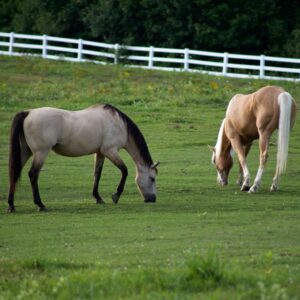 Feed Management Should Mimic Nature: By understanding the horse’s instinctive feeding behavior, today’s feeding strategies can be shaped to mimic natural tendencies. Certain feeding behaviors in horses are triggered by physiological changes and signals. Hormones, nerve signals, and homeostatic mechanisms lead to feelings of hunger. That hunger urges the horse to move around and look for something to eat. In a natural setting, the horse would wander about, lower its head, and graze while smelling and tasting various forages.
Feed Management Should Mimic Nature: By understanding the horse’s instinctive feeding behavior, today’s feeding strategies can be shaped to mimic natural tendencies. Certain feeding behaviors in horses are triggered by physiological changes and signals. Hormones, nerve signals, and homeostatic mechanisms lead to feelings of hunger. That hunger urges the horse to move around and look for something to eat. In a natural setting, the horse would wander about, lower its head, and graze while smelling and tasting various forages.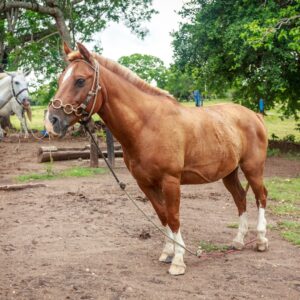 Restricting Forage Intake in Stubbornly Obese Horses: A medley of contributing factors can lead to obesity in horses. For example, overfeeding, sedentary lifestyle, genetics, and hormonal imbalances. Management of obesity involves evaluating every component of the diet and removing superfluous calories.
Restricting Forage Intake in Stubbornly Obese Horses: A medley of contributing factors can lead to obesity in horses. For example, overfeeding, sedentary lifestyle, genetics, and hormonal imbalances. Management of obesity involves evaluating every component of the diet and removing superfluous calories.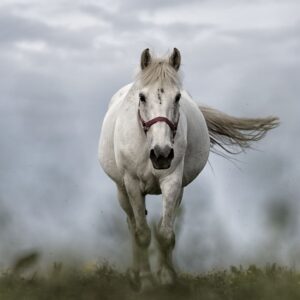 Feeding Horses Before Exercise: What to Feed and When? Three experiments were conducted to evaluate if feeding hay with and without grain affects glycemic response and hematological responses in Thoroughbred horses at rest and during a simulated competition exercise test on a high-speed treadmill. The first experiment evaluated how feeding forage along with grain influences plasma variables and water intake. The second experiment was conducted to determine whether these changes affect exercise performance. The third experiment was conducted to determine how forage alone affects exercise response.
Feeding Horses Before Exercise: What to Feed and When? Three experiments were conducted to evaluate if feeding hay with and without grain affects glycemic response and hematological responses in Thoroughbred horses at rest and during a simulated competition exercise test on a high-speed treadmill. The first experiment evaluated how feeding forage along with grain influences plasma variables and water intake. The second experiment was conducted to determine whether these changes affect exercise performance. The third experiment was conducted to determine how forage alone affects exercise response. Considerations When Moving Horses to a Different Climate: Do you travel a lot? Then you know that you need to pack shorts for a Florida vacation. Mayne throw in an extra jacket for a winter visit to those New England cousins? Of course, stock up on antacid before you spend a few weeks with your great-aunt, an enthusiastic chef in Europe. In today’s equestrian world horses routinely move south for the winter training months. They fly to Germany for a dressage lesson. O Or possible, shuttle to the opposite hemisphere for a second breeding season. Therefore, owners need to think about ways to minimize stress. Here are tips to help equines make a smooth transition to another climate, a modified diet, and a different exercise routine.
Considerations When Moving Horses to a Different Climate: Do you travel a lot? Then you know that you need to pack shorts for a Florida vacation. Mayne throw in an extra jacket for a winter visit to those New England cousins? Of course, stock up on antacid before you spend a few weeks with your great-aunt, an enthusiastic chef in Europe. In today’s equestrian world horses routinely move south for the winter training months. They fly to Germany for a dressage lesson. O Or possible, shuttle to the opposite hemisphere for a second breeding season. Therefore, owners need to think about ways to minimize stress. Here are tips to help equines make a smooth transition to another climate, a modified diet, and a different exercise routine.